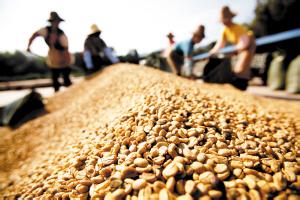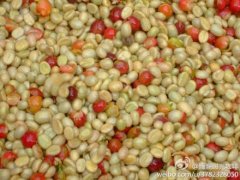Processing method of Fine Coffee Fruit Coffee beans Sun-drying of coffee beans

After the wet treatment, the coffee beans are still preserved in the inner pericarp, which still contains about 15% water. The endocarp must be dried to a moisture content of about 11% to ensure that coffee beans are stored in a stable and safe environment. Water content is critical, because if Arabica beans are overdried to a moisture content of 10%, they will lose their original turquoise and their quality will decline.
Coffee beans covered with endocarp should be laid flat on the cement floor, slate floor, dry table or plate, which is very similar to the drying method.
Mechanical dryers are sometimes used on larger plantations or where Rain Water may disrupt the drying process. Coffee beans are placed in an air-conditioning box and the dry wind blows on the surface of the coffee beans. The drying process can also be done by the sun, and coffee beans should be turned regularly to ensure complete dryness, a process that takes 12 to 15 days. The most important thing is that the endocarp should not be cracked. If the sun is too strong, the coffee beans must be covered.
At this point, the whole process is completed, coffee beans become known as "parchment coffee beans (parchment coffee)" (because the endocarp of coffee beans is quite like parchment, it is called). In general, coffee beans are kept in this form until the eve of export.
Since countries that produce coffee beans need to export coffee beans throughout the year rather than just about three months of harvest, coffee beans should be stored in the form of "parchment coffee beans" in an absolutely stable environment. High temperature is the enemy of coffee beans, and it is easy to damage coffee beans when the humidity reaches 70%. For this reason, "parchment coffee beans" are generally not stored on farms where they are produced (although there is no choice in some places). Coffee beans grown in the highlands should be stored at or near the same altitude as the places where they are grown, as they are particularly vulnerable to humidity. In this environment, Arabica coffee beans should not be stored for more than 12 hours, while Robbins coffee beans can be stored for a little longer.
Important Notice :
前街咖啡 FrontStreet Coffee has moved to new addredd:
FrontStreet Coffee Address: 315,Donghua East Road,GuangZhou
Tel:020 38364473
- Prev

Processing methods of coffee beans Wet treatment of coffee beans
There are two ways to prepare coffee beans for the baking process. The method chosen has a significant impact on the final price and quality of coffee. The cheapest method of processing is called drying, which is used for lower-grade coffee beans, while higher-quality coffee beans are processed by wet treatment. The wet treatment process requires more capital investment and more energy, but it helps to ensure
- Next

Analysis of grinding or shelling process of coffee beans
Coffee beans should be ground before they are exported, that is, the endocarp of Arabian and Robbite coffee beans to be sold should be removed. The residual shell of coffee beans after removal and cleaning of endocarp and drying process is also known as peeling or peeling. It is more difficult to remove the endocarp of coffee beans during wet treatment than during drying, so different methods are needed.
Related
- Guji coffee producing area of Guji, Ethiopia: Humbela, Shakiso, Wulaga
- What is the most expensive variety of Qiloso in BOP multi-variety group?
- How to store the coffee beans bought home?
- Why are Yemeni coffee beans so rare now?
- Ethiopian Sidamo all Red Fruit Sun Sun Santa Vini Coffee beans
- SOE is mostly sour? What does it mean? Is it a single bean? what's the difference between it and Italian blending?
- Is Italian coffee beans suitable for making hand-brewed coffee?
- How to choose coffee beans when making cold coffee? What kind of coffee beans are suitable for making cold coffee?
- Just entered the pit to make coffee, what kind of coffee beans should be chosen?
- Can only Japan buy real Blue Mountain Coffee? What are authentic Jamaican Blue Mountain coffee beans?

